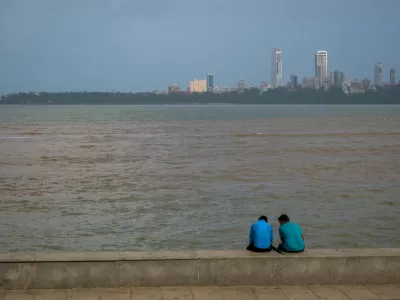A critique of a proposed "smart cities" development in Mumbai reveals how much work remains in providing the resources and maintaining the rigor to built sustainable, resilient, liveable cities.

Hugh Byrd revisits an ambitious proposal by the Indian Government to build 100 "smart cities," with a case study provided by a development in Mumbai known as Bhendi Bazaar. The 40- to 60-story towers that will replace three- to five-story townhomes have been described as "vertical with a vengeance" in its approach to density.
Byrd, however, has analyzed the project's plans using an Urban metabolism model, "which measures the impacts of the built environment, we have assessed its overall impact."
The result of that analysis was not favorable: "Our research shows that the proposal is neither smart nor sustainable." In more detail, Byrd reveals how the project falls short of the Indian government's own definitions of "smart"—as measured by 11 objectives.
The kicker of the post is not about the failure of engineering or development relative to the ambitions promoted to the public, but rather that the planning goal of making cities smart and liveable lacks the resources to become a reality.
FULL STORY: Smart or dumb? The real impact of India’s proposal to build 100 smart cities

Alabama: Trump Terminates Settlements for Black Communities Harmed By Raw Sewage
Trump deemed the landmark civil rights agreement “illegal DEI and environmental justice policy.”

Planetizen Federal Action Tracker
A weekly monitor of how Trump’s orders and actions are impacting planners and planning in America.

The 120 Year Old Tiny Home Villages That Sheltered San Francisco’s Earthquake Refugees
More than a century ago, San Francisco mobilized to house thousands of residents displaced by the 1906 earthquake. Could their strategy offer a model for the present?

Ken Jennings Launches Transit Web Series
The Jeopardy champ wants you to ride public transit.

BLM To Rescind Public Lands Rule
The change will downgrade conservation, once again putting federal land at risk for mining and other extractive uses.

Indy Neighborhood Group Builds Temporary Multi-Use Path
Community members, aided in part by funding from the city, repurposed a vehicle lane to create a protected bike and pedestrian path for the summer season.
Urban Design for Planners 1: Software Tools
This six-course series explores essential urban design concepts using open source software and equips planners with the tools they need to participate fully in the urban design process.
Planning for Universal Design
Learn the tools for implementing Universal Design in planning regulations.
Clanton & Associates, Inc.
Jessamine County Fiscal Court
Institute for Housing and Urban Development Studies (IHS)
City of Grandview
Harvard GSD Executive Education
Toledo-Lucas County Plan Commissions
Salt Lake City
NYU Wagner Graduate School of Public Service




























